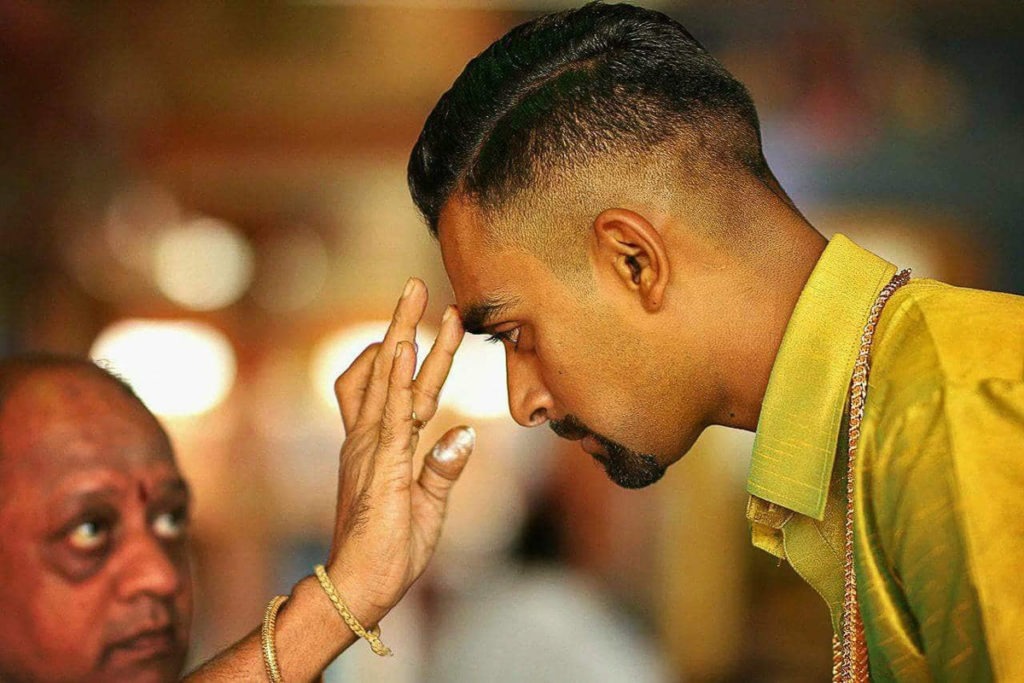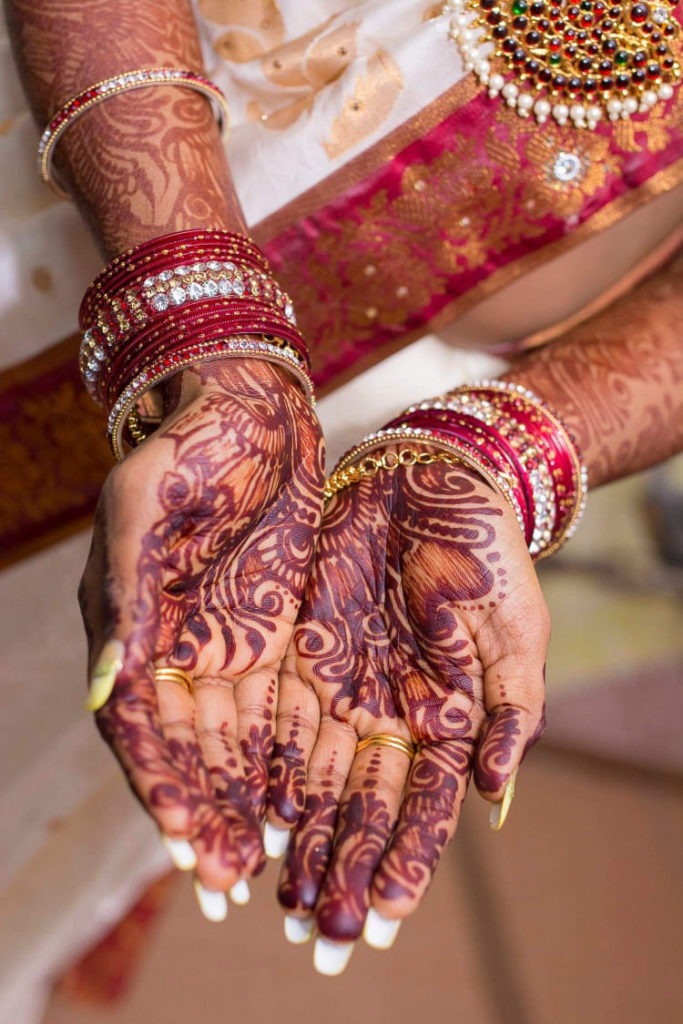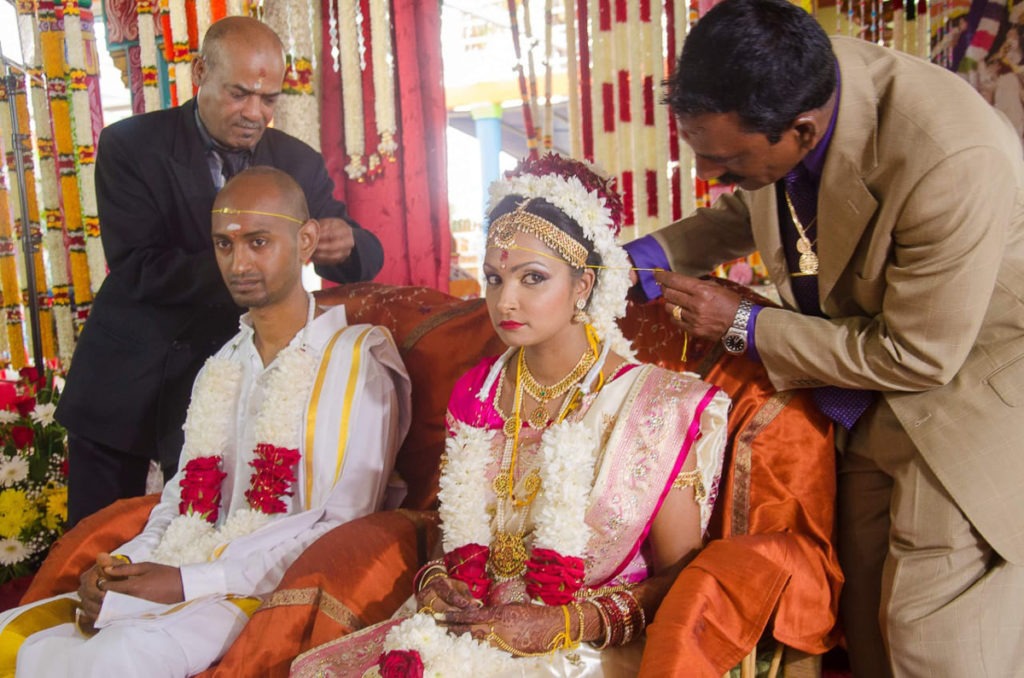
Veemanda Curpen shares the elaborate rituals and shared joy of her brother’s wedding, in full Tamil tradition with a Mauritian twist.
(A message to the reader in French/Creole.)
(A message to the reader in English.)
“If the married life possesses love and virtue, these will be both its duty and reward’’, is a unique and famous Tamil wedding invitation line in Mauritius from Thiruvalluvar, Thirukkural, which embodies all the prayers and hopes of every soon-to-be brides and grooms. How do Hindu Tamilans, on our small island, make sure that all the Hindu Gods and Goddesses of wisdom and salvation, gracefully bless our weddings when being called upon on that auspicious day? Through an immersion into the wedding celebration of Kovilen, my only brother and Amrita, I will endeavour to give an overall picture of how following the sequence of rituals meant to unite two souls, in accordance to the Hindu oldest scriptures (the Vedas), which epitomises one of our most auspicious customs.
The passage of time did make few inroads on the inherited Tamil wedding traditions in Mauritius. Indeed, nobody could escape the western influence or the globalised wedding trends, but it was important for both families that the ceremony remained a solemnised sacrament. I would like to point out that 200 years has passed by since the Indian immigrants’ arrival, there has been a complex cultural evolution in Mauritius, where practices have adapted to local contexts and situations.

Pre-wedding
The pre-wedding arrangements all started with the selection of a favourable day by the family priest (Gurukal) because according to Tamil Panchangam, certain periods should be avoided for their inauspiciousness. The first ritual, the paadal kaal Muhurtham, which is usually held a few days before the wedding, set the stage to a peaceful wedding. A bamboo pole, with a white handkerchief marked with vermillion and turmeric tied at the top, was erected by few married ladies, our close aunts, to seek the blessings of the family deity (usually with a Ganesha prayer) to ensure that the remover of obstacles can protect the couple and the proceedings from evil. From that day, both Kovilen and Amrita got ready in their own respective houses. They constrained themselves from meeting each other and ensured that they returned home before sunset.
Came the eve of the wedding day, a Saturday. A gathering took place separately, to honour the bride and the groom. This event was particularly marked by a get together that united both family members and friends around a typical South Indian dish known as the “7 curries”. The latter used to be traditionally served on fresh banana leaves, but it has eventually given way to paper banana leaves for practical reasons these days. Though no particular ritual is performed on that day, it remains an important event meant for socialising and presenting gifts to the to-be couple. The evening, on both sides, as would dictate traditions, was animated by local artists and musicians and ended on an ecstatic note by a dance party.
Cleansing ritual
The most awaited day for Amrita and Kovilen finally arrived. The day started early in the morning, the auspicious time being before sunrise. It was marked by the Nalangu ceremony, which was carried out mainly by my mother and my aunts. It first took place at our house and then continued at Amrita’s home, since tradition requests that all items used for the groom’s ceremony should then be passed on to the bride. The whole ceremony symbolised a cleansing and purification ritual during which my brother and my to-be-sister-in-law were made to sit on a mat. Next to each of them was a tray containing items like turmeric paste, kumkum, flowers and rice meant for the rituals. The ladies, in turn, would apply the turmeric and kumkum before blessing my brother with flowers. A token of appreciation was then offered to our aunties who then in turn concluded the ceremony with a traditional kummi (clapping of hands) dance.
Engagement ceremony
The wedding ceremony started with a significant ritual that marked the first step to the union of the two families. The Groom’s and the Bride’s Maamans (their respective mother’s brother) appeared on stage for an exchange of offerings. The Gurukal (priest) blessed them along with the Ponnu’s (Bride) and Mappillai’s (Groom) wedding clothes and flower garlands (Maalais). According to Tamil customs, the Maalai is representative of unity.
The ritual that followed is the Paroosam (engagement ceremony) where the Kovilen and the Amrita were introduced in turn by their uncle. The priest implored the grace and blessings of Lord Ganesha, who as per the Hindu traditions, is worshipped at the start of every sacred ceremony, for the removal of obstacles and for success in the new couple’s married life. A grass ring (Thepai grass has special and auspicious characteristics) was inserted on their right ring finger, and a sacred thread, dipped in turmeric, was tied around the Groom’s and Bride’s wrist as a symbol of protection.
- The bride’s uncle accompanies her to the Mandapam.
As previously mentioned, a Hindu Tamil wedding is interlinked with specific rites, among which is the Arasani kaal Nadudal, ceremony that involved three ladies representing the three main goddesses in Hinduism: Parvathi, Lakshmee and Sarasvathi. This rite, during which they lit a lamp, planted and sprinkled water on a tree, symbolised a new life, and was performed in order to obtain the blessings of the preserver of the world, Lord Vishnu. It also signified their wishes concerning the prosperity and fertility of the couple.
After that, both Kovilen and Amrita withdrew themselves to get ready in their marriage costume. In the meantime, guests were entertained by Govindarajen, a young dancer, who gracefully performed a sumptuous Bharatanatyam (an Indian classical dance that originated in the state Tamil Nadu). It was then followed by a group of instrumental musicians, who drifted the guests away through their music, which was delectably mellow.
The arrival

Suddenly the flamboyant sound of the Nadaswaram and Thavil (classical south Indian instrumental music) announced the arrival of the bride and groom, both dressed in South Indian traditional wedding attire. Amrita timidly but gracefully moved along, adorned in a white and green Kanchipuram (South Indian traditional saree) while my brother was clothed in a veshti. In Mauritius, despite all modern influences, the bride’s jewellery and attire remain very traditional. She also wore a special-made floral adornment called poo jadai or kalyana jadai (braided adorned flowers) which is considered auspicious.

At the entrance of the wedding hall, Amrita’s elder brother, Vishal stood as the Mappillai thozan (Bride’s brother), waiting nervously for the arrival of Kovilen. At that very moment, he felt that he was legitimately handing over his sister to Kovilen’s family by performing the rituals between brother-in-laws. He washed the Groom’s feet before placing a silver toe-ring (mindji) in each of his second toe. This ritual means that the former accepts the latter as his brother, in his heart, home and family. In return, my brother offered Vishal a ring and a shirt as presents. An aarti ceremony was then performed around the Groom and the Bride by a married woman to remove all negative energies before the sacrament.
Along with the ongoing sound of the Nadaswaram and Thavil, Amrita and Kovilen entered the wedding hall, under the admiring eyes of their closed-ones. Each of them is accompanied by his/her maaman and both followed by ladies carrying platefuls of cakes and fruits because in Hinduism, no marriage is complete without the exchange of gifts.
Family blessings
On the wedding mandapam (wedding stage), a kumbam (brass pot) filled with holy water, topped with a coconut head, symbolising the deities, have already been arranged and ornamented with flowers, mango leaves (considered as auspicious during sacred ceremonies) and Thepai (grass). It came the time for me to perform my sisterly duty as Ponnu Thozi/ tholi (Groom’s sister), which was to stand behind my brother. So did Amrita’s brother (Mappillai Thozan/ tholan) who in turn placed himself behind his sister—a ritual in the name of the bond of brotherhood, when we attend to our sibling on the manavarai (the stage where the wedding took place). Our parents also joined the ceremony. The priest blessed the couple with sacred water before lighting the Agni Saatchi, (the holy witness to the communion) and offering prayers to the divinities to bless them.
Since Hindu culture revolves around love and respect for others, the Bride and the Groom sought their parents’ blessings by washing and prostrating at their feet.
This act of humility, respect and devotion is known as the Paadha Poojai. The ceremony that followed was the Kannika Dhanam (giving away of daughter), a moment high in symbolism and marked by intense emotion, especially for Amrita’s parents. The couple was made to join hands, palms up, with the Bride’s hands uppermost. A coconut and betel leaves were then placed in the Amrita’s hands. Her parents closed their hands in turn over hers at the top while my parents held the whole structure by covering those of my brother’s at the bottom. The whole ceremony symbolised the flow of responsibility from the Bride’s parents to the Groom while they solemnly declared that they were giving away their daughter and were accepting my brother, as their son-in-law, in front of the witnessing eyes of the guests present.
The sacred union

The Mangalya Poojai during which my brother tied the yellow thread (Thali) around Amrita’s neck, marked the sacred union of the couple. In the presence of Goddess Lukshmee, represented by a lit lamp, and invoked by the priest for a long married life, this ceremony is carried out fervently. The Groom tied one knot and my old aunt, Sarojah, who stood behind the couple during the rituals, completed the three knots. For the first time, Kovilen applied kungumum (kumkum powder) on Amrita’s forehead as a sign of wedlock. This is a significant mark for all married women in the traditional Hindu society as it is a visible indication of their wish for their husband’s longevity. This is a solemn moment of the wedding ceremony where flowers were showered over the newly-weds, a symbol of the Gods’ blessings.
The exchange of garlands between the Bride and the Groom, also known as the maalai maatral, followed the previous ritual. They exchanged their maalai (garlands) three times as a symbol of the Divine Trinity: Brahma (Creator), Vishnu (Sustainer) and Shiva (Destroyer). It bore important significance to the wedding ceremony as it symbolised the union of two souls as one.
Like in India, by law and tradition, no sacrament of marriage is complete in Hinduism unless the ritual of the seven steps and vows in presence of fire is completed by the Groom and the Bride. My brother, at that instant, officially took Amrita’s hand and led the way towards the seven steps together. They circled the sacred fire three times as a symbol of their journey together. While the couple made their rounds, they declared their commitment towards each other.

The first vow comprised of their willingness to shoulder and share responsibilities and to provide for the welfare and happiness of their newly founded family. The second vow addressed their commitment to remain loyal and faithful towards each other and they promised to give all the support they possibly could to one another. While the groom vowed that he would give protection to his wife and children, she consented that with strength and courage she would carry out her duties as a wife. Through his third vow, the groom took vows to hard work to sustain his family welfare and prosperity. On her side, the bride vowed of her support to sustain the resources and promised to maintain chastity towards her husband. The fourth vow dealt with their commitment towards each other’s family and shared responsibility in decision making. The Bride, on her side, agreed to always be by her husband’s side and to strive for his happiness and well-being. The fifth vow was one that swore mutual understanding, care and shared happiness as well as sorrows. The couple carried out the sixth vow by taking the pledge to love and respect each other and to stand together in times of joy and grief. The final vow was a promise for unconditional love and care to one another. They conclude with the promise to honestly abide by all the vows taken during this sacred ritual. These oaths embody a mutual prayer to the Lord for a blissful and successful married life.
The toe ring

The Tamil wedding is filled with symbolism in the rituals practices and among the most important one is the ammi midithal. This ritual took place after the third tour around the fire. Kovilen placed Amrita’s foot on a batan stone, symbol of a strong foundation, and placed a mindji (a toe ring known as metti in Tamil) on the second toe of each foot. The toe ring symbolizes the marital status of the new bride and their unfailing faithfulness to each other.
The Bride and Groom swapped their seating positions. Amrita sitting on the left of her husband’s side signified that she would now strengthen her husband’s weaker side. A small golden plate (pattam) was then tied on the Bride’s and the Groom’s foreheads by their respective uncles, thus bestowing a new status upon the married couple. At the end of the ceremony, after receiving their uncles’ and parents’ blessings, all the guests were invited on the mandapam (stage) to shower their blessings and good wishes upon the newlyweds. The wedding ended merrily with the distribution of cakes and refreshments.
The reception
During the reception, also known as the Virunthu, the second most awaited moment, held in honour of the new couple and meant to celebrate the union of our two families, finally arrived. It was held on the same day, later in the afternoon at a wedding hall, a fairy tale set up, put in place by our close friends and cousins. A feast of colours, savours and fragrances awaited our guests on their arrival. Family and friends cheered the royal entrance of Kovilen and Amrita, exquisitely dressed in a black suit and white dress respectively.
This wedding epitomised the Mauritian exotic blend of cultures. Though it was a Hindu wedding, it was dressed in European attire, catered by Chinese snacks and celebrated on the beat of the African originated music, the Sega. After the dinner, offered to celebrate this momentous occasion, and that comprised of delicious South Indian dishes, the DJ, set the mood and tempo for an unforgettable evening party. We danced the night through and at midnight we bid a heartfelt farewell, packed with warmest wishes, to the newlyweds.
Several years ticked away after the wedding. This write-up and the photographs will remain the living memories of the pre-wedding tedious preparations, the memorable moments of the ceremony and celebrations and the enjoyment of the post-wedding gathering.
Author
 Veemanda Curpen Seeneevassen, originally from Mauritus, journeyed the country of her ancestral origin, India, several times. She states that returns to the roots are essential to keep us anchored. She actually works as a lecturer and head of the Printmaking department at the School of Fine Arts, Mahatma Gandhi Institute. With other staffs of her school, she will imminently hold an international printmaking workshop from 17-27 March 2020.
Veemanda Curpen Seeneevassen, originally from Mauritus, journeyed the country of her ancestral origin, India, several times. She states that returns to the roots are essential to keep us anchored. She actually works as a lecturer and head of the Printmaking department at the School of Fine Arts, Mahatma Gandhi Institute. With other staffs of her school, she will imminently hold an international printmaking workshop from 17-27 March 2020.



















